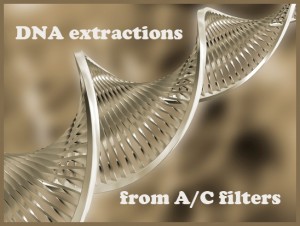 One of our goals at microBEnet is to increase communication and collaboration between people working in the disparate fields that make up the “microbiology of the built environment”. Most of what we’ve posted about in the past relates to general information and events… but we’d also like to host more technical information that would help people doing the work on the ground.
One of our goals at microBEnet is to increase communication and collaboration between people working in the disparate fields that make up the “microbiology of the built environment”. Most of what we’ve posted about in the past relates to general information and events… but we’d also like to host more technical information that would help people doing the work on the ground.
Yesterday our lab was having some troubles with DNA extractions from A/C filters and I e-mailed some questions to folks at the BioBE Center and got back this extremely helpful response from Adam Altrichter (@atrickster).
***********************************************************************************************************
Hey David — sounds like you’re having trouble with inhibitors! The good news is that if you’re extracting a dirty supernatant there’s a very good chance you should have DNA in that sample. Bad news is that the dirty-ness could be preventing you from getting any good, amplifiable DNA out of the sample. In general the power soil kits are pretty good at cleaning up samples, but not perfect.
- Make sure you’re using a positive control (something you know will amplify) in your PCR so that you know the PCR should have actually worked (i.e. you didn’t forget a reagent or something).
- Try a dilution series on your DNA template (dilute in tris or water). 1:10, 1:100, 1:1000, even 1:10000 are not uncommon for soil samples.
- If you really suspect it’s inhibitor issues, which it sounds like it is, try spiking each of your samples with the positive control — if it doesn’t amplify it means something intrinsic to your sample is hindering amplification and not just low biomass. Try this set up:
- Tube 1: sample DNA
- Tube 2: Positive control DNA
- Tube 3: Sample DNA + Positive control DNA
- Tube 4: negative control
4. James mentioned BSA (bovine serum albumin) — try adding BSA (0.1-0.8ug/uL) which can help in samples with high impurities.
5. Try running an annealing temperature gradient, starting lower than you might expect.
6. Run more cycles…anywhere 25-40 cycles.
7. Do an additional phenol:chloroform extract of the template to remove impurities.
8. You can try to make all sorts of tweaks to your PCR — changing MgCl2 levels, adding more/less template or Taq, adding DMSO or betaine in combination with BSA has been shown to help.
RT @arturgreensward: New post at #microBEnet Troubleshooting 16S PCR from A/C filters… (h/t @atrickster): http://t.co/yGuhQvWiuE
@phylogenomics @atrickster nice reference, will be pointing some of our newbies there :) use BSA cautiously and do controls per batch…
@phylogenomics @atrickster recently tracked down bad contamination to BSA which was contaminated at source – mol biology grade, for PCR.
@phylogenomics @atrickster varied from tube to tube in intensity, even within same lot – Sigma.
@MikeyJ @phylogenomics wow, I just received a batch from NEB…we’ll see how clean it is.
@atrickster @phylogenomics reagents tend not to b guaranteed DNA free, just DNase, Protease etc. worse with low biomass samples good luck :)
New at #microBEnet: Troubleshooting 16S PCR from A/C filters (or other annoying substrates): One of our goals … http://t.co/soL4HF7rNc
Great to see #BioBE training in action: troubleshooting 16S PCR from A/C filters (or other annoying substrates) http://t.co/MbDe6l6yZe
RT @JessicaLeeGreen: Great to see #BioBE training in action: troubleshooting 16S PCR from A/C filters (or other annoying substrates) htt …
RT @JessicaLeeGreen: Great to see #BioBE training in action: troubleshooting 16S PCR from A/C filters (or other annoying substrates) htt …
New at #microBEnet: Troubleshooting 16S PCR from A/C filters (or other annoying substrates): One of our goals … http://t.co/cMiFfZzPMt
RT @Dr_Bik: New at #microBEnet: Troubleshooting 16S PCR from A/C filters (or other annoying substrates): One of our goals … http://t.c …